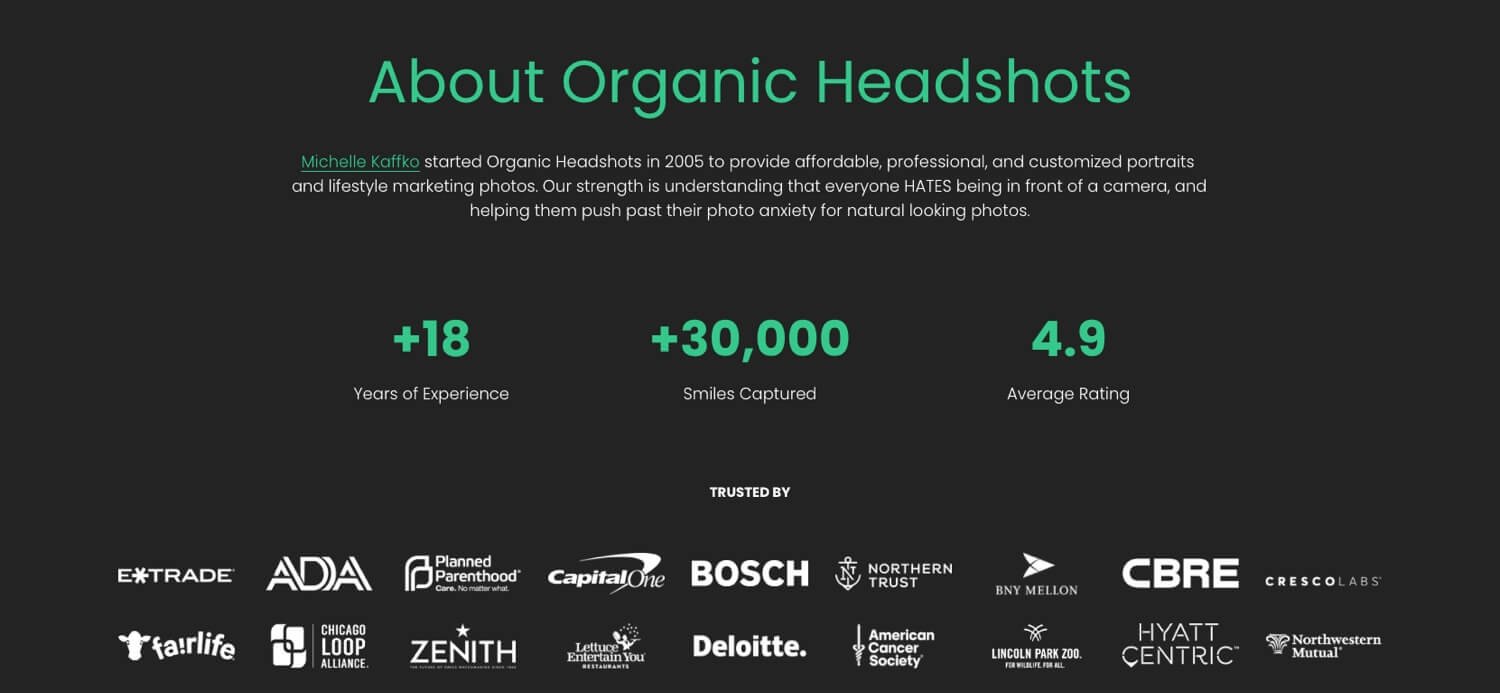How to Write a Compelling About Page
When it comes to creating a new website, there’s a lot to consider. Your design needs to stand out from the crowd, your site needs to be easy to navigate, your home page needs to capture interest immediately, and your services need to be clear and enticing.
Then, there’s your About (or About Us) page.
Writing a page about you should be easy, right?
The problem with most About pages is that they do exactly that – they focus entirely on the business or person’s history, accomplishments, and goals.
It's easy to fall into the trap of thinking an About page should be a comprehensive biography of yourself or your business. While sharing your background is an essential part of this page, its true purpose goes far beyond telling your own story.
Follow this guide to learn 8 key steps for writing an effective, compelling, and still true-to-you About page!
The true purpose of your about page
The About page is a powerful tool for forging connections and building trust. While the About page offers the opportunity to introduce yourself and your brand, its primary function is to show how your brand can relate to your audience.
This means you need to share your story in a way that:
keeps the focus on clients’ needs,
empathizes with their challenges, and
shows you have the expertise to provide a solution.
Your About page is also the ideal place to showcase additional authority and credibility that might not fit elsewhere on your website. This is where you can proudly display your accolades, awards, memberships, education, certifications, or affiliations that reinforce your expertise.
Finally, the About page is where you can have fun with your brand personality. This is the space to connect with your audience on a more personal level.
8 steps to write an effective about page
Writing your About page can feel daunting, but breaking it down into digestible pieces makes it easier. Follow these eight essential steps to help you create a compelling About page that engages your readers, builds trust, and showcases your unique brand identity:
Reinforce what you do or offer
Highlight your unique value proposition
Share your brand’s purpose
Tap into your brand story
Tell your story while maintaining empathy with the audience
Build trust with credibility signals
Infuse your brand personality
Guide your readers with a call to action
1. Reinforce what you do or offer
You know your business inside and out, but your potential customers will have questions.
Take away the guesswork and uncertainty by reminding them what you do, who you do it for, and the success you create.
Be specific about your products or services. Avoid using jargon or technical language, even if your business is in a technical industry.
Here’s an example from the About page of Rise Digital, a tech consultant company. In just a few sentences, they explain what they do and establish the importance of their work.
2. Highlight your unique value proposition
Your Unique Value Proposition (UVP) is what sets you apart from others in your field. Do you have a unique approach? Unbeatable customer service? More impactful results? Stress-free guarantees?
Use the About page to highlight one or several reasons why your offerings are different or more valuable than others (no matter your pricing).
Here’s a great example from a photography studio named Organic Headshots. The introduction of their About page not only explains their unique approach to photography, the benefits to clients, but also the statistics that speak to their credibility.
Saying your UVP is one thing, making your audience believe in it is another story. What if you don’t have the stats to back up your claims?
A workaround to enhance your credibility is providing details.
Here’s an example from 1st ROW Wine Estate. Not only do they claim to have excellent wine quality, but they also show the details of their wine-making process that make for an exceptional drinking experience.
3. Share your brand’s purpose
Expressing your brand's mission, values, or philosophy helps your audience understand your underlying beliefs – as long as these relate to helping them solve problems. This adds depth to your brand and will instantly forge a connection between you and the customers who share your values.
For mission-driven businesses, sharing the beliefs that drive the work you do can also make new visitors feel right at home with your business.
Here’s an example from Sincerely Teaching’s About page. Their brand story focused on the shared pain points experienced by the founder and their audience.
4. Tap into your brand story
It’s no secret that storytelling is a powerful way to connect with your audience in marketing. However, your brand story shouldn’t be about you, but the transformational journey you guide your customers or clients through. When reading your brand story, your clients should see themselves at the center as the hero, while you’re the guide who helps them get there.
Share a high-level version of this story to remind readers that you understand where they are now, and have the tools and dedication to help them achieve their goals.
Check out Clockwork Talk for a great example of how to lead with a concise yet powerful brand story on your About page.
5. Tell your story while maintaining empathy with the audience
There might be many elements about your background and why you started the business.
Focus on the parts of your story that relate most to what your target audience is going through themselves, and how through your experience, you’re able to understand and/or create a better solution for them.
You can discuss how you've faced similar challenges and used your expertise to overcome them. This not only humanizes your brand but also makes you relatable.
In some cases, you may not want to share your personal story at all. That’s totally okay, even when you’re a solopreneur. Here’s an example from LauChereState’s About page which focuses entirely on the customers’ pain points and how their solution fixes it.
6. Build trust with credibility signals
Rather than telling your audience you’re an expert, show them.
Share your qualifications, certifications, awards, news stories, number of people served or dollars saved, or any other notable achievements that make you the person or business best suited to help them.
Here’s an example of Dadapt’s About page showcasing the news outlets where the brand has been featured:
This is also a great place to share social proof such as testimonials from satisfied clients, success statistics, or case studies.
However, don’t worry if your company is new and you don’t have these credibility signals yet. You don’t need to exaggerate your accomplishments to gain credibility; your approach and authenticity will do the job. Which brings us to the next part:
7. Infuse your brand personality
While your brand personality should come through all aspects of your website and marketing, your About page is really where you can let it shine.
Whether you're professional and serious or casual and playful, your tone and style should align with your brand identity. Even visuals (like the images, videos, and design you choose) can showcase your brand's culture and personality.
For personal brands, this means going beyond listing your accomplishments and credentials. Use the power of story to highlight the experiences, struggles, and victories that make you relatable to your target audience.
For bigger businesses and enterprises, infusing personality can feel like a challenge. But, you can still maintain your credibility without having your About page read like a corporate history lesson.
People do business with people they know, like and trust. Humanize your brand by showcasing the people and stories behind it. Share anecdotes about how your team's journey aligns with the needs and aspirations of your customers. This helps create an emotional connection that goes beyond transactional relationships.
Image: Example of Organic Headshots’s About page highlighting each team member’s strength and uniqueness in a way that is relevant to their clients.
8. At the last step, guide your readers with a call to action
Now that you’ve given your potential customers deeper insight into your philosophy, your expertise, and how you can help them, it’s time to call them to action.
What do you want them to do after reading your About page?
Whether it's subscribing to your newsletter, exploring your products or services, or contacting you for a consultation, make your call to action clear and simple.
Image: Example of ending the about page with a strong call-to-action
Connect and convert with a strategic and authentic about page
An About page can be so much more than a list of credentials or company history. When crafted with strategy, storytelling, and brand personality, your About page can be the key factor that turns website visitors into confident, trusting, excited new clients.
If you’re writing (or re-writing) your About page, take it step-by-step. Or, schedule a free consultation to learn how we can help you nail the process.









